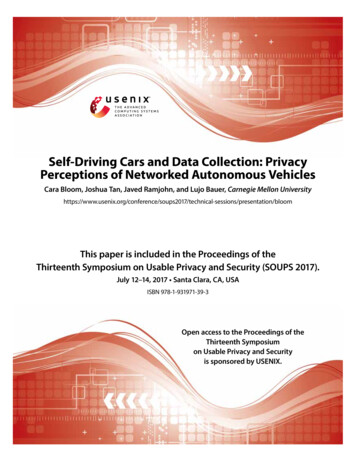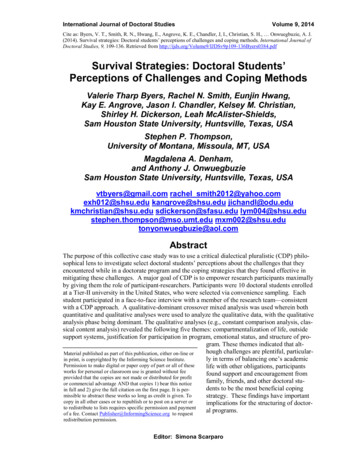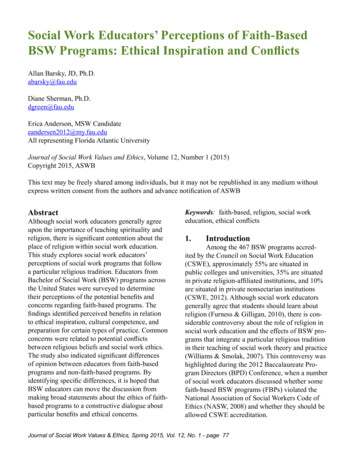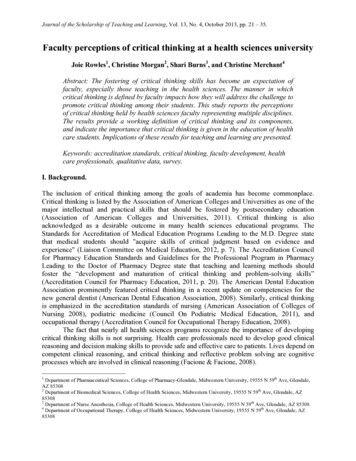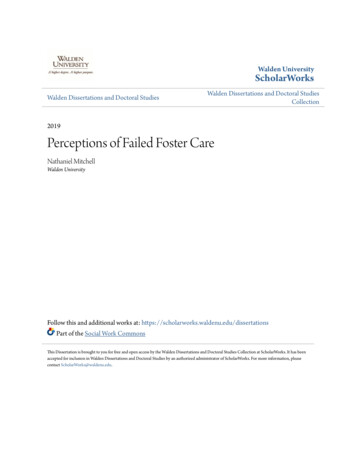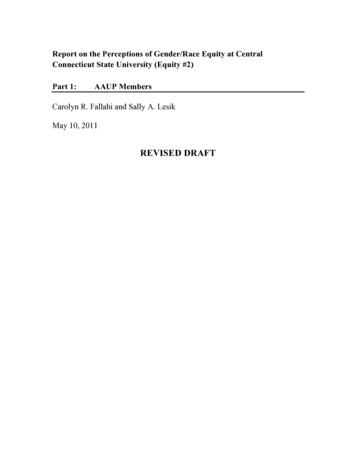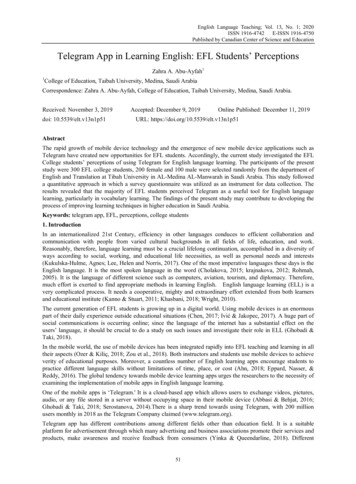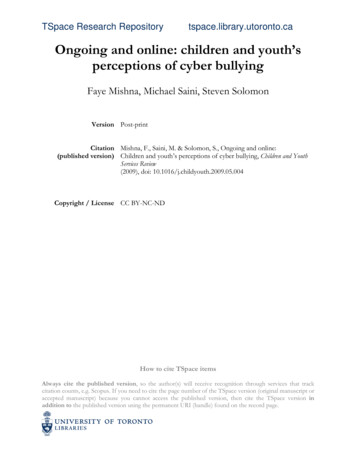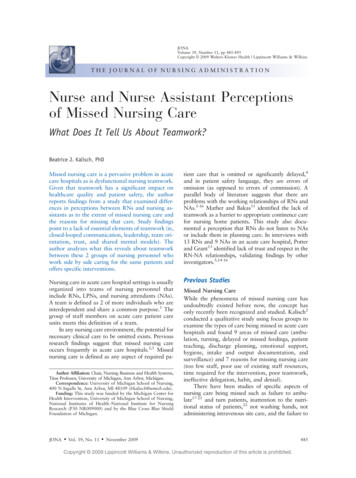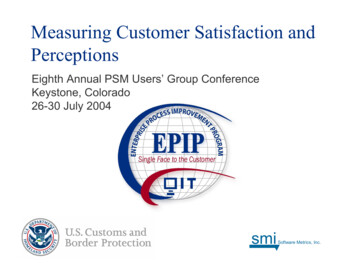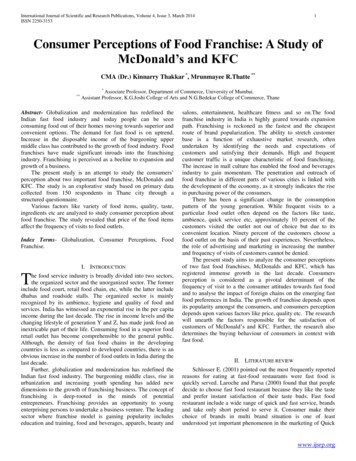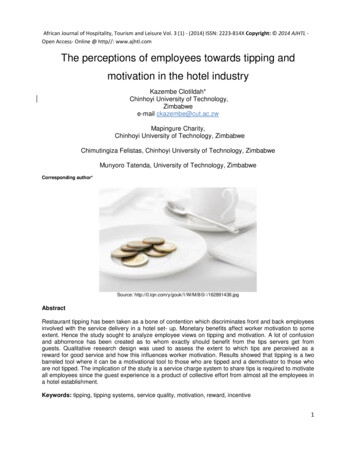
Transcription
African Journal of Hospitality, Tourism and Leisure Vol. 3 (1) - (2014) ISSN: 2223-814X Copyright: 2014 AJHTL Open Access- Online @ http//: www.ajhtl.comThe perceptions of employees towards tipping andmotivation in the hotel industryKazembe Clotildah*Chinhoyi University of Technology,Zimbabwee-mail ckazembe@cut.ac.zwMapingure Charity,Chinhoyi University of Technology, ZimbabweChimutingiza Felistas, Chinhoyi University of Technology, ZimbabweMunyoro Tatenda, University of Technology, ZimbabweCorresponding author*Source: bstractRestaurant tipping has been taken as a bone of contention which discriminates front and back employeesinvolved with the service delivery in a hotel set- up. Monetary benefits affect worker motivation to someextent. Hence the study sought to analyze employee views on tipping and motivation. A lot of confusionand abhorrence has been created as to whom exactly should benefit from the tips servers get fromguests. Qualitative research design was used to assess the extent to which tips are perceived as areward for good service and how this influences worker motivation. Results showed that tipping is a twobarreled tool where it can be a motivational tool to those who are tipped and a demotivator to those whoare not tipped. The implication of the study is a service charge system to share tips is required to motivateall employees since the guest experience is a product of collective effort from almost all the employees ina hotel establishment.Keywords: tipping, tipping systems, service quality, motivation, reward, incentive1
African Journal of Hospitality, Tourism and Leisure Vol. 3 (1) - (2014) ISSN: 2223-814X Copyright: 2014 AJHTL Open Access- Online @ http//: www.ajhtl.comIntroductionA tip is defined as “a gift or a sum of moneytendered for a service performed oranticipated” (Webster, 2011). However, thetippee (server) views a tip as a reward forproviding quality service and moreimportantly – a supplement of their income(Brewstera & Mallinsonb, 2009).Lin and Namasivayam (2007) propose thatit is important to understand tipping systemsnot only from the customers‟ point of view,but also from that of employees‟. A lot ofconfusion and abhorrence has been createdas to whom exactly should benefit from thetips servers get from guests. Mkono (2011)posit that in Zimbabwe the culture of tippinghas a significant impact on employee workrelationships. He further notes that thesetips have the potential either to build andfortify relationships or to damage them,especially when tables are shared and a tipis given. In this case strong friendships andcamaraderie are possible or the oppositecan be true. Lack of trust and an aura ofsuspicion can develop in the restaurant as aresult of such tendencies, creating, in thelong term, a general lack of esprit de corpseand, in some cases, forcing some waiters toleave the job. However this research wascarried out to further assess the relationshipbetween tips and motivation for goodservice which were not examined by(Mkono 2011; Brewstera & Mallinsonb,2009; Lin and Namasivayam 2007; Azar2003; Ogbonna and Harris, 2002; Wessels,1997). The purpose of this study sought toestablish the influence between tipping andmotivation of restaurant food serviceemployees. The specific objectives were to:1 assess the views of restaurant foodservice employees towards tipping inZimbabwe,2. To explore the relationship betweentipping and worker motivation3. Recommend best practices in tippingfor hotels in Zimbabwe.The significance of this research is that itmay assist restaurant managers inunderstanding, and managing tips andworker motivation for quality servicedelivery. More specifically, hotel managerscan gain insight into tipping systems andtheir variables that impact on waitermotivation with a view to using them as atool for superior service quality.Literature ReviewTipping is used to describe a phenomenonwhere customers give out extra money tohospitality professionals like waiters andwaitresses, bartenders and other serversafter paying their bills for services (Azar2003). A tip also called a gratuity is moneytendered for a service performed oranticipated. The tip is at the discretion of thepatron being served and is a reward forservices rendered (Brewster and Zachary2009). In tipping, the waiter provides anexceptional service and rewarded by theguest as a gratuity. Pinder (1998) defineswork motivation as the set of internal andexternal forces that initiate work-relatedbehaviour, and determine its form, direction,intensity, and duration. The definitionrecognizes the desire to exert high levels ofefforttowardorganizationalgoals,conditioned by the effort‟s ability to satisfysome individual need. An essential featureof the definition is that it views workmotivation as an invisible, internal,hypothetical construct (Pinder, 1998). Wecannot actually see work motivation nor canwe measure it directly. The idea of usingtips as a tool to motivate service employeesin the restaurant and its controversy arequite interesting.There is a plethora of research in the field oftipping. Most research focus on tipping as asocial norm of some countries, racialdifferences in tipping (black- white), ethnicdifferences in tipping, tipping and service2
African Journal of Hospitality, Tourism and Leisure Vol. 3 (1) - (2014) ISSN: 2223-814X Copyright: 2014 AJHTL Open Access- Online @ http//: www.ajhtl.comquality, tipping behavior of diners, tippingsystems in hotels, motivation to tip.However none seem to focus on the supplyside perceptions given the nature of theservice industry that requires the tip offeringat the end of service delivery. The waiter/waitress perceptions in the hotels havebeenignoredinresearchstudiesconcerning the whole tipping norm. Yet theyare the catalyst between the hotel and theguest in the encounter. Research on tippinghas been conducted in various disciplinessuch as economics, sociology, andpsychology, but most research focused ontipping from customers‟ perspectives andwhy customers tip (Azar, 2011; 2010; 2008;2007; 2005; 2003; Lynn, 2003; Wessels,1997). However, limited literature on tippingfrom the employees‟ perspective is available(Curtis et al., 2009; Liu, 2008; Shamir,1983).The server‟s own view of thepractice of tipping is very crucial in theservice cycle as they are the front stage thatdelivers a service to the guest during the‟moment of truth‟.There are various factors which explain whycustomers tip and the need for better qualitywas discovered to be the major reason whycustomers provide tips (Speer 1997;Zapone 2006; Gatta 2009). One commonexplanation for tipping is that it is the mostefficient way to provide service workers withperformance-contingent rewards and tomotivate them to deliver good service Lynn,Kwortnik and Sturmam (2010). Panwar andGupta (2012) and Kwortnik, Lynn, and Ross(2009) concur in their research that moneyis a motivational tool for employees. Theirstudies found out that money whether it is inthe form of pay or some other kind ofremuneration is an obvious motivation. Thismeans that the use of the tip in the hotelfrom the guest has a motivational effect onthe server and their productivity levels.These factors illustrate that the waiter‟sbehavior has an influence on the tippingbehavior of the customer.Brewstera and Mallinsonb, 2009; Azar2008; Lynn, 2003) opine that guests tippedbasing on the sex of the waiter, size of thedining party, economic status of the tipper,number of courses ordered, and diningparty‟s consumption of alcohol. In the caseof the last two, the waiter can influence thebehavior of the customer to a degreethrough his/her selling techniques, Koku(2005) and Lynn and Larate (2008).According to the motivation theory byVroom (1964) employees efforts will lead toperformance which will lead to rewards.Rewards may be either positive or negative.The more positive the reward the morelikely the employee will be highly motivated.Conversely, the more negative the rewardthe less likely the employee will bemotivated. It is further argued by Lynn,(2003, 2001) that there is a weak correlationbetween tip levels and service, althoughmany managers insist on basing employeemotivation on tip levels. The practice oftipping enables workers to get extrarewards, however it discriminates in thatonly those workers who interface withclients are the ones who get the rewards,yet worker act collectively to provide aservice to customers. Tipping is always themain motivation for servers in the restaurantand hotel industry, Zahari ,Rashdi ,Radziand Othman (2011). Employees‟ areactually appreciating the reward receivedand it acts as their main motivation to servebetter next time around (Zahari, Rashdi,Radzi and Othman, (2011). There is need toalso assess whether tipping has an impacton the motivational levels of non tipped.Apart from the employees, the hotel hasbeen found to gain from this norm of tippingwhich Lynn and Withiam,(2008) argued asmajor gains from tipping to the business asit; lowers nominal prices, increases profitsthrough price discrimination, acts as anincentive for up-selling and service, attractscompetent workers, and lowers tax3
African Journal of Hospitality, Tourism and Leisure Vol. 3 (1) - (2014) ISSN: 2223-814X Copyright: 2014 AJHTL Open Access- Online @ http//: www.ajhtl.compayments. The same organization gains arenoted by Zachary (2012) with specialemphasis on leaving the tipping institution tothe waiter/tress as a monitoring and qualitycontrol measure. It is estimated that overthree million people earn an income fromtips and this can be connected to theeconomic wellbeing of society (Curtis,Upchurch & Severt 2009). These areindicative of some of the factors thatinfluence hotels to continue acceptingtipping as a norm for quality service.Systems of tipping in hotelsAccording to Lin and Namasivayam (2011)there are many different tipping systems theworld over but only three general categoriesof distributing tips have been widely used.These include the equal sharing of tips(without a service charge) or restaurantscan adopt equal sharing of tips (including aservice charge) or agree to have no sharingof tips (servers retain all the tips).In their study they also highlight thepreference for the pooled tipping systemwhich provides high levels of controlamongst the servers. The use of a servicecharge can be fair and just as a tippingsystem because a flat fee expressed as apercentage of the total bill will be levied tothe guest by the service organization(Boyes, 2006) and then shared equally butthis can arguably cause varying levels ofmotivation. Customers may be discouragedfrom tipping because the tendency is to tipthat person who would have provided theservice. The employee perceptions on thesesystems are more important as tips are areward for the exceptional service thus theneed to implement systems that theemployeesuggests.Weaver(1988)developed Theory M as a potentialmotivating way to make employees feel thatthey are being paid what they are worth.Weaver‟s primary motivator was money.The incentive would be paid as soon aspossible after the service. However thistheory then might mean that the back of thehouse employees are not providing anexceptional service and yet they provide thefront servers with the meals attractively andon time. This theory may well explain whyPanwar and Gupta (2012) posit that moneycan provide positive motivation in the rightcircumstance, not only because peopleneed and want money but also because itserves as a highly tangible means ofrecognition. It can beconsidered as a "scorecard" through whichemployees can evaluate how much they areworth.Motivations of tippingTipping is either motivated by social orpsychological motives by the guest as away of rewarding excellent service.However servers‟ behavior influences thesize and frequency of the tips. As Azar(2004: 60) points out, tipping “has attracteda lot of attention from psychologists, butlittle from economists”. It has also attractedlittle attention from other social sciences.The motivation to tip thus becomes a verydicey issue and can only be further exploredthrough the perceptions of the servers, asthey influence tips through their service. Thetips are a motivational tool that can be usedto retain servers and this is of crucialimportance to the success of hotels,because this can avert the high costsassociated with turnover (Dermody, Young,& Taylor, 2004). It becomes the employers‟task to better understand and motivateworkers. This fact has been noted by Enz(2001) who posits that the number oneproblem in the hospitality industry is thecare and motivation of human capital.Hence motivation might be a key driver toincrease service delivery and exploring theperceptions of tips as a motivator need tobe understood.4
African Journal of Hospitality, Tourism and Leisure Vol. 3 (1) - (2014) ISSN: 2223-814X Copyright: 2014 AJHTL Open Access- Online @ http//: www.ajhtl.comMethodologyObservation GuideQualitative design was used throughinterviews, questionnaires and on sightobservation.The researchers also observed the waitersduring the service period to note down anypeculiar and phenomenal actions takingplace during the service encounter.Observation has been used in a variety ofdisciplines as a tool for collecting data aboutpeople, processes, and cultures inqualitative research. Observation providesresearchers with ways to check fornonverbal expression of feelings, determinewho interacts with whom, grasp howparticipants communicate with each other,and checks for how much time is spent onvariousactivities(Schmuck,1997).Nonparticipant observation, was used whichrequires no intervention by the researcher. Itis simply studying behaviors that occurnaturally in natural contexts, unlike theartificial environment of a controlledlaboratory setting. Importantly, in naturalisticobservation, there is no attempt tomanipulate variables.Questionnaire GuideThe question
Rewards may be either positive or negative. The more positive the reward the more likely the employee will be highly motivated. Conversely, the more negative the reward the less likely the employee will be motivated. It is further argued by Lynn, (2003, 2001) that there is a weak correlation
